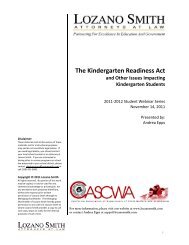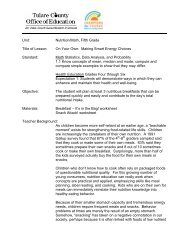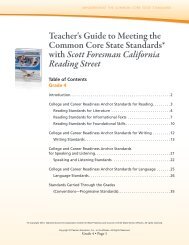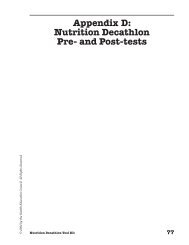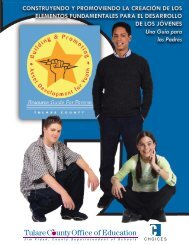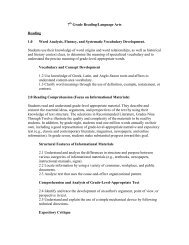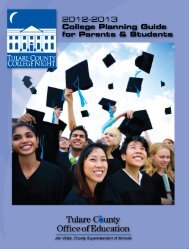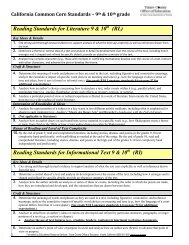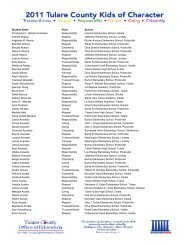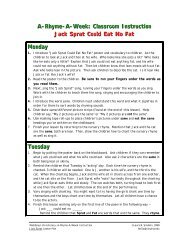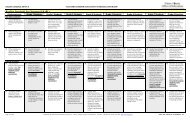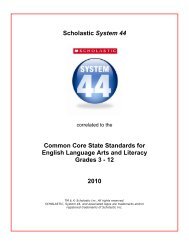Transitioning to California's Common Core Content Standards for ...
Transitioning to California's Common Core Content Standards for ...
Transitioning to California's Common Core Content Standards for ...
Create successful ePaper yourself
Turn your PDF publications into a flip-book with our unique Google optimized e-Paper software.
<strong>Transitioning</strong> <strong>to</strong> Cali<strong>for</strong>nia’s<br />
<strong>Common</strong> <strong>Core</strong><br />
<strong>Content</strong> <strong>Standards</strong><br />
<strong>for</strong> Grade 4<br />
with<br />
Pearson
Grade 4<br />
Table of <strong>Content</strong>s<br />
Table of <strong>Content</strong>s<br />
<strong>Transitioning</strong> <strong>to</strong> a <strong>Common</strong> <strong>Core</strong> Classroom<br />
with enVisionMATH ® Cali<strong>for</strong>nia....................................................................................................... 2<br />
<strong>Standards</strong> <strong>for</strong> Mathematical <strong>Content</strong> — Grade 4 Overview .........................................................3<br />
<strong>Standards</strong> <strong>for</strong> Mathematical Practice...............................................................................................7<br />
Correlation of Cali<strong>for</strong>nia’s <strong>Common</strong> <strong>Core</strong> <strong>Content</strong> <strong>Standards</strong><br />
<strong>to</strong> enVisionMATH Cali<strong>for</strong>nia Grade 4 ............................................................................................13<br />
Pacing <strong>for</strong> a <strong>Common</strong> <strong>Core</strong> Curriculum with enVisionMATH Cali<strong>for</strong>nia ................................19<br />
Listing of Supplemental <strong>Common</strong> <strong>Core</strong> Lessons.........................................................................29<br />
Grade 4<br />
Table of <strong>Content</strong>s<br />
Table of <strong>Content</strong>s<br />
<strong>Transitioning</strong> <strong>to</strong> a <strong>Common</strong> <strong>Core</strong> Classroom<br />
with enVisionMATH ® Cali<strong>for</strong>nia....................................................................................................... 2<br />
Cali<strong>for</strong>nia’s <strong>Common</strong> <strong>Core</strong> <strong>Content</strong> <strong>Standards</strong>— Grade 4 Overview ......................................... 3<br />
<strong>Standards</strong> <strong>for</strong> Mathematical Practice...............................................................................................7<br />
Correlation of Cali<strong>for</strong>nia’s <strong>Common</strong> <strong>Core</strong> <strong>Content</strong> <strong>Standards</strong><br />
<strong>to</strong> enVisionMATH Cali<strong>for</strong>nia Grade 4 ............................................................................................13<br />
Pacing <strong>for</strong> a <strong>Common</strong> <strong>Core</strong> Curriculum with enVisionMATH Cali<strong>for</strong>nia ................................19<br />
Listing of Supplemental <strong>Common</strong> <strong>Core</strong> Lessons.........................................................................29<br />
Grade 4<br />
<strong>Transitioning</strong> <strong>to</strong> a <strong>Common</strong> <strong>Core</strong> Curriculum<br />
<strong>Transitioning</strong> <strong>to</strong> a <strong>Common</strong> <strong>Core</strong> Curriculum<br />
with enVisionMATH® Cali<strong>for</strong>nia<br />
Pearson is committed <strong>to</strong> supporting Cali<strong>for</strong>nia teachers as they transition <strong>to</strong> a mathematics<br />
curriculum that is based on Cali<strong>for</strong>nia’s <strong>Common</strong> <strong>Core</strong> <strong>Content</strong> <strong>Standards</strong> <strong>for</strong> Mathematics.<br />
This commitment includes not just curricular support, but also professional development<br />
support <strong>to</strong> help members of the education community gain greater understanding of the<br />
new standards and of the expectations <strong>for</strong> instruction.<br />
With this guide, we offer overview in<strong>for</strong>mation about both the <strong>Standards</strong> <strong>for</strong> Mathematical<br />
<strong>Content</strong> and <strong>for</strong> Mathematical Practice, the two sets of standards that make up Cali<strong>for</strong>nia’s<br />
<strong>Common</strong> <strong>Core</strong> <strong>Content</strong> <strong>Standards</strong> <strong>for</strong> Mathematics. In the Overview of the <strong>Standards</strong> <strong>for</strong><br />
Mathematical <strong>Content</strong>, teachers can become aware of critical shifts in content or<br />
instructional focus in the new standards as they begin planning a <strong>Common</strong> <strong>Core</strong>-based<br />
curriculum. In the <strong>Standards</strong> <strong>for</strong> Mathematical Practice essay, we present the features and<br />
elements of Scott Foresman Addison Wesley enVisionMATH Cali<strong>for</strong>nia ©2009 that provide<br />
students with opportunities <strong>to</strong> meet these standards and develop mathematical proficiency.<br />
You will also find a correlation of enVisionMATH Cali<strong>for</strong>nia ©2009 Grade 4 <strong>to</strong> Cali<strong>for</strong>nia’s<br />
<strong>Common</strong> <strong>Core</strong> <strong>Content</strong> <strong>Standards</strong> <strong>for</strong> Mathematics – Grade 4. The correlation includes the<br />
supplemental lessons that will be made available <strong>to</strong> ensure comprehensive coverage of all<br />
of content standards <strong>for</strong> Grade 4. Additionally, we have included Pacing <strong>for</strong> a <strong>Common</strong><br />
<strong>Core</strong> Curriculum, a pacing guide that recommends when each of the supplemental lessons<br />
should be taught. Look <strong>for</strong> the lessons with a lower case letter as part of the lesson number<br />
(i.e., 4-3a, 8-8b).<br />
Finally, we offer a listing of the supplemental lessons that will be made available summer<br />
2011. These lessons maintain the successful instructional approach of the enVisionMATH<br />
Cali<strong>for</strong>nia ©2009, while highlighting the connections <strong>to</strong> the <strong>Standards</strong> <strong>for</strong> Mathematical<br />
Practice. <br />
2
Grade 4<br />
Grade 4 Overview<br />
Cali<strong>for</strong>nia’s <strong>Common</strong> <strong>Core</strong> <strong>Content</strong> <strong>Standards</strong><br />
Grade 4 Overview<br />
Main Areas of Emphasis<br />
• Multi-digit multiplication and concepts of division with multi-digit dividends<br />
• Fraction equivalence and operations (addition, subtraction, and multiplication) with<br />
fractions and whole numbers<br />
• Analysis and classification of two-dimensional shapes based on properties and attributes<br />
Students extend their study of multiplication <strong>to</strong> four-digit numbers by one- and two-digit<br />
numbers. Drawing on their understanding of models of multiplication developed in Grade 3,<br />
students develop strategies and methods <strong>to</strong> find products of multi-digit whole numbers.<br />
Students also build on their conceptual understanding of division, place value, properties of<br />
operations, and the relationship between multiplication and division <strong>to</strong> develop procedures <strong>to</strong><br />
find quotients involving multi-digit dividends.<br />
Students build on their understanding of unit fractions and fraction equivalence <strong>to</strong> compare<br />
fractions with different numera<strong>to</strong>rs and denomina<strong>to</strong>rs. They extend their understanding of<br />
operations and unit fractions <strong>to</strong> add and subtract fractions with like denomina<strong>to</strong>rs, and use<br />
visual representations <strong>to</strong> explain their work; <strong>for</strong> example, they decompose fractions in<strong>to</strong> the sum<br />
of unit fractions <strong>to</strong> add and subtract fractions and mixed numbers with like denomina<strong>to</strong>rs.<br />
Further, they draw from their understanding of multiplication and unit fractions as they explore<br />
multiplying fractions and whole numbers.<br />
Grade 4 students extend their understanding of the properties of two-dimensional shapes by<br />
describing and analyzing shapes, looking in particular at the angles and lines of shapes <strong>to</strong><br />
categorize them (e.g., triangles, quadrilaterals). Students also explore line symmetry.<br />
3
Grade 4<br />
<strong>Standards</strong> <strong>for</strong> Mathematical <strong>Content</strong><br />
New Approaches <strong>to</strong> <strong>Content</strong> in Grade 4<br />
The <strong>Common</strong> <strong>Core</strong> State <strong>Standards</strong> <strong>for</strong> Mathematics promote the development of not just<br />
conceptual and procedural understandings of operations, but also an analytic framework from<br />
which students begin <strong>to</strong> see patterns in the way operations function. In Grade 4, students<br />
<strong>for</strong>malize their understanding of the standard algorithm <strong>for</strong> multiplication and division. They<br />
explore another meaning of multiplication: as comparison; <strong>for</strong> example, one student has five<br />
times as many pencils as another student. They analyze the multiplicative comparison and the<br />
additive comparison. Students interpret remainders of division problems <strong>to</strong> maintain a<br />
contextual meaning <strong>for</strong> the operations.<br />
As students develop fluency with multiplication, they explore another classification of numbers<br />
as fac<strong>to</strong>rs and multiples. They find all fac<strong>to</strong>r pairs <strong>for</strong> whole numbers <strong>to</strong> 100 and identify<br />
numbers as multiples of a single-digit number. Students classify numbers as prime or<br />
composite.<br />
In Grade 4, students begin a <strong>for</strong>mal study of patterns <strong>to</strong> lay a foundation <strong>for</strong> algebraic thinking.<br />
Students generate patterns that follow a rule and describe the pattern, identifying features of the<br />
pattern that are not explicit <strong>to</strong> the rule itself. Students also begin <strong>to</strong> represent problem situations<br />
with equations that include a letter or symbol <strong>to</strong> represent an unknown as part of the foundation<br />
<strong>for</strong> algebraic thinking.<br />
The <strong>Common</strong> <strong>Core</strong> State <strong>Standards</strong> recommend using the unit fraction <strong>to</strong> build students’<br />
knowledge of fractions. In Grade 4, addition and subtraction of fractions grow from composing<br />
unit fractions in<strong>to</strong> fractions and decomposing fractions <strong>to</strong> unit fractions. Similarly, students’<br />
work with multiplying fractions begins with the understanding of a fraction as a multiple of a<br />
unit fraction, with special attention <strong>to</strong> the size of the whole. This contextualization of fractions <strong>to</strong><br />
the parts of the wholes that they represent is an important concept in the study of fractions.<br />
Students realize while ½ always represents one half of a whole, the halves are not equal if the<br />
whole are different sizes.<br />
Students’ work with data displays integrates their study of fractions. They make line plots with<br />
the horizontal scale marked off in halves, fourths, and eighths and solve problems involving<br />
addition and subtraction of fractional values presented on the line plots.<br />
Students extend their study of place value and rounding <strong>to</strong> 1,000,000 in Grade 4. They <strong>for</strong>malize<br />
the relationship among the places in a multi-digit number (i.e., power of 10). Further, they<br />
express numbers in different <strong>for</strong>ms: using base-ten numerals (standard <strong>for</strong>m), number names<br />
(word <strong>for</strong>m) and expanded <strong>for</strong>m. They achieve fluency with multi-digit addition and<br />
subtraction.<br />
4
Grade 4<br />
<strong>Standards</strong> <strong>for</strong> Mathematical <strong>Content</strong><br />
Important Progressions across Grades<br />
Grade 4 students continue the study of multiplication and division that they started in Grade 3.<br />
They expand their understandings of the meaning of multiplication <strong>to</strong> include multiplication as<br />
comparison (e.g., 5 times as many objects) and distinguish between multiplicative comparison<br />
and additive comparison (e.g., 5 more). Student multiply multi-digit numbers, using strategies<br />
based on place value and properties of operations, and provide visual explanations of their<br />
calculations (e.g., area models, rectangular arrays). By Grade 5, students will achieve fluency<br />
with multi-digit multiplication using the standard algorithm.<br />
Grade 4 students carry out multi-digit division calculations with dividends up <strong>to</strong> four digits and<br />
one-digit divisors. They use strategies based on place value, properties of operations, and the<br />
inverse relationship between multiplication and division. As they did with multiplication<br />
calculations, students explain their solutions <strong>to</strong> division problems using visual models or<br />
equations. Students also interpret remainders, explaining the meaning <strong>for</strong> each problem<br />
context. In Grade 5, students will find quotients of division problems with four-digit dividends<br />
and two-digit divisors and in Grade 6, will achieve fluency with multi-digit whole number<br />
division using the standard algorithm.<br />
Students began their <strong>for</strong>mal study of fractions in Grade 3, with an emphasis on unit fractions<br />
and their representation on the number line. In Grade 4, students focus on equivalence of<br />
fractions and compare fractions using visual models. They apply their knowledge of unit<br />
fractions and fraction equivalence <strong>to</strong> compare fractions with different numera<strong>to</strong>rs or<br />
denomina<strong>to</strong>rs. Grade 4 students draw from their understanding of operations and fraction<br />
equivalence <strong>to</strong> add and subtract fractions and mixed numbers with like denomina<strong>to</strong>rs. In Grade<br />
5, they will extend these operations <strong>to</strong> fraction with unlike denomina<strong>to</strong>rs. Students will explore<br />
multiplying fractions by whole numbers <strong>to</strong> ground their understanding in the meaning of the<br />
operation. In Grade 5, students will multiply fractions and fractions, and explore division of<br />
fractions by whole numbers and vice versa. By Grade 6, students become fluent with all<br />
operations involving fractions, including decimal fractions.<br />
Grade 4 students begin their study of decimal fractions. They use decimal notation <strong>for</strong> fractions<br />
with denomina<strong>to</strong>rs of 10 and 100, and compare decimals <strong>to</strong> hundredths. Grade 5 students<br />
undertake a comprehensive study of decimals. Starting with decimal place value, students read,<br />
write, and compare decimals <strong>to</strong> the thousandths. They apply their understandings of operations<br />
(addition, subtraction, multiplication, and division) with whole numbers <strong>to</strong> operations with<br />
decimals. By the end of Grade 6, they have mastered operations with decimals.<br />
Grade 4 students draw from the measurement concepts and skills developed in earlier years <strong>to</strong><br />
solve problems involving distance (linear measure from Grades 1 through 3), time intervals<br />
(Grades 1 and 2), liquid volume (Grades 2 and 3), mass (Grades 2 and 3), and money (Grade 2).<br />
Students know the relative sizes of units of measurement and can express unit measurements<br />
from a larger in terms of a smaller unit.<br />
In Grade 4, students continue <strong>to</strong> build on their reasoning on the attributes of shapes from<br />
Grades 1 through 3. They focus specifically on angles and lines. Students classify shapes based<br />
on the angles (right, acute, obtuse) and lines (perpendicular, parallel) that make up the shapes.<br />
Students also look <strong>for</strong> line symmetry in shapes as a defining attribute.<br />
5
Grade 4<br />
<strong>Standards</strong> <strong>for</strong> Mathematical <strong>Content</strong><br />
What’s Different?<br />
Unlike many state curriculum frameworks, the <strong>Common</strong> <strong>Core</strong> State <strong>Standards</strong> do not present a<br />
spiral curriculum in which students revisit numerous <strong>to</strong>pics from one year <strong>to</strong> the next with<br />
progressively more complex study. Rather, the CCSS identify a limited number of <strong>to</strong>pics at each<br />
grade level, allowing enough time <strong>for</strong> students <strong>to</strong> achieve mastery of these concepts. The<br />
subsequent year of study builds on the concepts of the previous year. While some review of<br />
<strong>to</strong>pics from earlier grades is appropriate and encouraged, the CCSS writers assert that<br />
reteaching of these <strong>to</strong>pics should not be needed.<br />
Certain <strong>to</strong>pics that have often been part of the Grade 4 curriculum are not included in the CCSS.<br />
Among the most noticeable are a pared-down set of geometry and data analysis standards, and<br />
the absence of probability concepts. Other <strong>to</strong>pics, such as operations with fractions and<br />
decimals have been shifted <strong>to</strong> different grades.<br />
Number and Operations The study of decimals in Grade 4 is limited <strong>to</strong> an exploration of<br />
decimal fractions. Students undertake operations with decimals in Grade 5. Operations with<br />
fractions are limited <strong>to</strong> addition and subtraction with like denomina<strong>to</strong>rs and multiplication of<br />
fractions and whole numbers.<br />
Measurement The study of temperature is not part of the CCSS.<br />
Geometry The CCSS introduce the study of congruence and trans<strong>for</strong>mations in Grade 8, and the<br />
study of coordinate grids begins in Grade 5. While students in Kindergarten through Grade 2<br />
explore three-dimensional shapes, compose them and compare and contrast them <strong>to</strong> twodimensional<br />
shapes, students do not revisit three-dimensional shapes until Grade 5 with the<br />
study of volume.<br />
Data Analysis Students represent data in picture or bar graphs in Grades 2 and 3, but have<br />
limited experiences with other data displays except line plots.<br />
Probability Students first encounter probability concepts in Grade 7. <br />
6
Grade 4<br />
<strong>Standards</strong> of Mathematical Practice<br />
<strong>Standards</strong> <strong>for</strong> Mathematical Practice<br />
Grade 4<br />
The <strong>Standards</strong> <strong>for</strong> Mathematical Practice are an important part of Cali<strong>for</strong>nia’s <strong>Common</strong> <strong>Core</strong><br />
<strong>Content</strong> <strong>Standards</strong>. They describe varieties of proficiency that teachers should focus on<br />
developing in their students. These practices draw from the NCTM process standards of<br />
problem solving, reasoning and proof, communication, representation, and connections and<br />
the strands of mathematical proficiency specified in the National Research Council’s report<br />
Adding It Up: adaptive reasoning, strategic competence, conceptual understanding, procedural<br />
fluency, and productive disposition.<br />
For each of the <strong>Standards</strong> <strong>for</strong> Mathematical Practice presented in the text that follows, is a<br />
explanation of the different features and elements of Pearson’s Scott Foresman • Addison Wesley<br />
enVisionMATH TM Cali<strong>for</strong>nia that help students develop mathematical proficiency.<br />
1 Make sense of problems and persevere in solving them.<br />
Mathematically proficient students start by explaining <strong>to</strong> themselves the meaning of a problem and<br />
looking <strong>for</strong> entry points <strong>to</strong> its solution. They analyze givens, constraints, relationships, and goals. They<br />
make conjectures about the <strong>for</strong>m and meaning of the solution and plan a solution pathway rather than<br />
simply jumping in<strong>to</strong> a solution attempt. They consider analogous problems, and try special cases and<br />
simpler <strong>for</strong>ms of the original problem in order <strong>to</strong> gain insight in<strong>to</strong> its solution. They moni<strong>to</strong>r and evaluate<br />
their progress and change course if necessary. Older students might, depending on the context of the<br />
problem, trans<strong>for</strong>m algebraic expressions or change the viewing window on their graphing calcula<strong>to</strong>r <strong>to</strong><br />
get the in<strong>for</strong>mation they need. Mathematically proficient students can explain correspondences between<br />
equations, verbal descriptions, tables, and graphs or draw diagrams of important features and<br />
relationships, graph data, and search <strong>for</strong> regularity or trends. Younger students might rely on using<br />
concrete objects or pictures <strong>to</strong> help conceptualize and solve a problem. Mathematically proficient<br />
students check their answers <strong>to</strong> problems using a different method, and they continually ask themselves,<br />
“Does this make sense? ”They can understand the approaches of others <strong>to</strong> solving complex problems<br />
and identify correspondences between different approaches.<br />
<br />
Scott Foresman • Addison Wesley enVisionMATH Cali<strong>for</strong>nia is built on a foundation of problembased<br />
instruction that has sense-making at its heart. The Problem Solving Handbook, found on<br />
pages xviii-xxix, presents <strong>to</strong> students a 3-phase process that begins with making sense of the<br />
problem <strong>to</strong> solve. The first phase of the process has students ask themselves, What am I trying <strong>to</strong><br />
find? What do I know? <strong>to</strong> help them identify the givens and constraints of a problem situation. In<br />
the second phase, the plan and solve phase, students decide on a solution plan. The Problem-<br />
Solving Recording Sheet, a reproducible teaching resource, provides students with a useful<br />
structured outline <strong>to</strong> help them become fluent with thinking about (making sense of) a problem<br />
and planning a workable solution pathway.<br />
The structure of each lesson facilitates students’ implementation of this process. Every lesson<br />
begins with Problem-Based Interactive Learning, an activity in which students are presented a<br />
problem <strong>to</strong> solve. They interact with their peers and teachers <strong>to</strong> make sense of the problem<br />
presented and <strong>to</strong> look <strong>for</strong> a workable solution. A second feature of each lesson are the Problem<br />
Solving exercises <strong>for</strong> which students persevere <strong>to</strong> find solutions <strong>for</strong> each exercise. In each <strong>to</strong>pic<br />
is at least one Problem Solving lesson with a primary focus of honing students’ sense-making<br />
and problem-solving skills.<br />
7
Grade 4<br />
<strong>Standards</strong> of Mathematical Practice<br />
Throughout the program; <strong>for</strong> examples, see Grade 4 Lessons 1-3, 1-8, 2-1, 2-2, 2-3, 2-4, 2-5, 2-6,<br />
3-6, 4-6,<br />
5-5, 6-6, 10-6, 10-8, 12-11, 13-10, 14-4, 14-6, 14-9, 14-10, 14-11, 15-5<br />
2 Reason abstractly and quantitatively.<br />
Mathematically proficient students make sense of quantities and their relationships in problem<br />
situations. They bring two complementary abilities <strong>to</strong> bear on problems involving quantitative<br />
relationships: the ability <strong>to</strong> decontextualize—<strong>to</strong> abstract a given situation and represent it<br />
symbolically and manipulate the representing symbols as if they have a life of their own, without<br />
necessarily attending <strong>to</strong> their referents—and the ability <strong>to</strong> contextualize, <strong>to</strong> pause as needed during<br />
the manipulation process in order <strong>to</strong> probe in<strong>to</strong> the referents <strong>for</strong> the symbols involved. Quantitative<br />
reasoning entails habits of creating a coherent representation of the problem at hand; considering<br />
the units involved; attending <strong>to</strong> the meaning of quantities, not just how <strong>to</strong> compute them; and<br />
knowing and flexibly using different properties of operations and objects.<br />
Scott Foresman • Addison Wesley enVisionMATH Cali<strong>for</strong>nia program provides scaffolded<br />
instruction <strong>to</strong> help students develop both quantitative and abstract reasoning. In the Visual<br />
Learning Bridge students learn how <strong>to</strong> represent the given situation numerically or<br />
algebraically. Later in a lesson, students have opportunities <strong>to</strong> reason abstractly as they<br />
endeavor <strong>to</strong> represent situations symbolically. Throughout the solving process, students are<br />
reminded <strong>to</strong> check back <strong>to</strong> the problem situation with the Reasonableness exercises. In the Do<br />
You Understand part of the Guided Practice, students gain experiences with quantitative<br />
reasoning as they consider the meaning of different parts of an expression or equation.<br />
Throughout the exercise sets are Reasoning exercises that focus students’ attention on the<br />
structure or meaning of an operation rather than the solution.<br />
Throughout the program; <strong>for</strong> examples, see Grade 4 Lessons 2-6, 5-4, 5-5, 7-3, 7-4, 8-5, 9-2, 10-3,<br />
10-8, 11-3, 12-5, 13-6, 14-11, 15-5.<br />
8
Grade 4<br />
<strong>Standards</strong> of Mathematical Practice<br />
3 Construct viable arguments and critique the reasoning of<br />
others.<br />
Mathematically proficient students understand and use stated assumptions, definitions, and<br />
previously established results in constructing arguments. They make conjectures and build a logical<br />
progression of statements <strong>to</strong> explore the truth of their conjectures. They are able <strong>to</strong> analyze<br />
situations by breaking them in<strong>to</strong> cases, and can recognize and use counterexamples. They justify<br />
their conclusions, communicate them <strong>to</strong> others, and respond <strong>to</strong> the arguments of others. They<br />
reason inductively about data, making plausible arguments that take in<strong>to</strong> account the context from<br />
which the data arose. Mathematically proficient students are also able <strong>to</strong> compare the effectiveness<br />
of two plausible arguments, distinguish correct logic or reasoning from that which is flawed, and—<br />
if there is a flaw in an argument—explain what it is. Elementary students can construct arguments<br />
using concrete referents such as objects, drawings, diagrams, and actions. Such arguments can make<br />
sense and be correct, even though they are not generalized or made <strong>for</strong>mal until later grades.<br />
Later, students learn <strong>to</strong> determine domains <strong>to</strong> which an argument applies. Students at all grades<br />
can listen or read the arguments of others, decide whether they make sense, and ask useful<br />
questions <strong>to</strong> clarify or improve the arguments.<br />
Consistent with a focus on reasoning and sense-making is a focus on critical reasoning –<br />
argumentation and critique of arguments. In Pearson’s Scott Foresman • Addison Wesley<br />
enVisionMATH Cali<strong>for</strong>nia, the Interactive Learning af<strong>for</strong>ds students opportunities <strong>to</strong> share<br />
with classmates their thinking about problems, their solutions, and their reasoning about the<br />
solutions. The many Reasoning exercises found throughout the program specifically call <strong>for</strong><br />
students <strong>to</strong> justify or explain their solutions. The Writing <strong>to</strong> Explain exercises help students<br />
develop foundational critical reasoning skills by having them construct explanations <strong>for</strong><br />
processes. Articulating clearly an explanation <strong>for</strong> a process is a stepping s<strong>to</strong>ne <strong>to</strong> critical analysis<br />
and reasoning of both their own processes and those of others.<br />
Throughout the program; <strong>for</strong> examples, see Grade 4 Lessons 5-6, 7-5, 11-8, 14-5, 16-11<br />
9
Grade 4<br />
<strong>Standards</strong> of Mathematical Practice<br />
4 Model with mathematics.<br />
Mathematically proficient students can apply the mathematics they know <strong>to</strong> solve problems arising<br />
in everyday life, society, and the workplace. In early grades, this might be as simple as writing an<br />
addition equation <strong>to</strong> describe a situation. In middle grades, a student might apply proportional<br />
reasoning <strong>to</strong> plan a school event or analyze a problem in the community. By high school, a student<br />
might use geometry <strong>to</strong> solve a design problem or use a function <strong>to</strong> describe how one quantity of<br />
interest depends on another. Mathematically proficient students who can apply what they know<br />
are com<strong>for</strong>table making assumptions and approximations <strong>to</strong> simplify a complicated situation,<br />
realizing that these may need revision later. They are able <strong>to</strong> identify important quantities in a<br />
practical situation and map their relationships using such <strong>to</strong>ols as diagrams, two-way tables, graphs,<br />
flowcharts and <strong>for</strong>mulas. They can analyze those relationships mathematically <strong>to</strong> draw conclusions.<br />
They routinely interpret their mathematical results in the context of the situation and reflect on<br />
whether the results make sense, possibly improving the model if it has not served its purpose.<br />
Students in Pearson’s Scott Foresman • Addison Wesley enVisionMATH Cali<strong>for</strong>nia, are<br />
introduced <strong>to</strong> mathematical modeling in the early grades. They first use manipulatives and<br />
drawings and then equations <strong>to</strong> model addition and subtraction situations. The Visual<br />
Learning Bridge and Visual Learning Animation often present real-world situations and<br />
students are shown how these can be modeled mathematically. In later years, students expand<br />
their modeling skills <strong>to</strong> include other graphical representations such as tables, graphs, as well as<br />
equations.<br />
Throughout the program; <strong>for</strong> examples, see Grade 4 Lessons 1-1, 1-9, 2-2, 3-3, 3-6, 4-2, 5-5, 8-4,<br />
9-1, 9-5, 10-5, 11-4, 12-1, 12-2, 12-5, 12-6, 12-9, 13-1, 13-2, 13-5, 13-7, 14-11, 15-5, 16-1, 16-2, 16-6<br />
5 Use appropriate <strong>to</strong>ols strategically.<br />
Mathematically proficient students consider the available <strong>to</strong>ols when solving a mathematical<br />
problem. These <strong>to</strong>ols might include pencil and paper, concrete models, a ruler, a protrac<strong>to</strong>r, a<br />
calcula<strong>to</strong>r, a spreadsheet, a computer algebra system, a statistical package, or dynamic geometry<br />
software. Proficient students are sufficiently familiar with <strong>to</strong>ols appropriate <strong>for</strong> their grade or<br />
course <strong>to</strong> make sound decisions about when each of these <strong>to</strong>ols might be helpful, recognizing both<br />
the insight <strong>to</strong> be gained and their limitations. For example, mathematically proficient high school<br />
students analyze graphs of functions and solutions generated using a graphing calcula<strong>to</strong>r. They<br />
detect possible errors by strategically using estimation and other mathematical knowledge. When<br />
making mathematical models, they know that technology can enable them <strong>to</strong> visualize the results<br />
of varying assumptions, explore consequences, and compare predictions with data. Mathematically<br />
proficient students at various grade levels are able <strong>to</strong> identify relevant external mathematical<br />
resources, such as digital content located on a website, and use them <strong>to</strong> pose or solve problems.<br />
They are able <strong>to</strong> use technological <strong>to</strong>ols <strong>to</strong> explore and deepen their understanding of concepts.<br />
Students become fluent in the use of a wide assortment of <strong>to</strong>ols ranging from physical objects,<br />
including manipulatives, rulers, protrac<strong>to</strong>rs, and even pencil and paper, <strong>to</strong> technological <strong>to</strong>ols,<br />
such as e<strong>to</strong>ols, calcula<strong>to</strong>rs and computers. As students become more familiar with the <strong>to</strong>ols<br />
available <strong>to</strong> them, they are able <strong>to</strong> begin making decisions about which <strong>to</strong>ols are more<br />
appropriate <strong>to</strong> solve different kinds of problems.<br />
Throughout the program; <strong>for</strong> examples, see Grade 4 Lessons 1-2, 1-4, 2-1, 2-5, 3-1, 4-1, 4-6, 5-1,<br />
5-3, 6-1, 6-6, 8-1, 8-3, 9-4, 10-3, 10-6, 11-2, 13-9, 14-1, 14-6, 15-1, 16-5, 16-10<br />
10
Grade 4<br />
<strong>Standards</strong> of Mathematical Practice<br />
6 Attend <strong>to</strong> precision.<br />
Mathematically proficient students try <strong>to</strong> communicate precisely <strong>to</strong> others. They try <strong>to</strong> use clear<br />
definitions in discussion with others and in their own reasoning. They state the meaning of the<br />
symbols they choose, including using the equal sign consistently and appropriately. They are careful<br />
about specifying units of measure, and labeling axes <strong>to</strong> clarify the correspondence with quantities<br />
in a problem. They calculate accurately and efficiently, express numerical answers with a degree of<br />
precision appropriate <strong>for</strong> the problem context. In the elementary grades, students give carefully<br />
<strong>for</strong>mulated explanations <strong>to</strong> each other. By the time they reach high school they have learned <strong>to</strong><br />
examine claims and make explicit use of definitions.<br />
Students are expected <strong>to</strong> use mathematical terms and symbols with precision. Key terms and<br />
concepts are highlighted in each lesson. In the Do You Understand feature, students often<br />
revisit these key terms and provide explicit definitions or explanations of the terms. For the<br />
Writing <strong>to</strong> Explain and Think About a Process exercises, students are <strong>to</strong> provide clear<br />
explanations of terms, concepts, or processes and <strong>to</strong> use new terms accurately and precisely.<br />
Students are reminded <strong>to</strong> use appropriate units of measure when working through solutions<br />
and accurate labels on axes when making graphs <strong>to</strong> represent solutions.<br />
Throughout the program; <strong>for</strong> examples, see Grade 4 Lessons 6-3, 6-4, 6-5, 8-1, 8-2, 8-3, 9-4, 10-3,<br />
10-6, 11-1, 11-2, 13-9, 14-1, 14-6, 15-1, 16-5, 16-6, 16-10<br />
7 Look <strong>for</strong> and make use of structure.<br />
Mathematically proficient students look closely <strong>to</strong> discern a pattern or structure .Young students,<br />
<strong>for</strong> example, might notice that three and seven more is the same amount as seven and three more,<br />
or they may sort a collection of shapes according <strong>to</strong> how many sides the shapes have. Later,<br />
students will see 7 × 8 equals the well remembered 7 × 5 × 7 × 3, in preparation <strong>for</strong> learning about<br />
the distributive property. In the expression x 2 + 9x + 14, older students can see the 14 as 2 × 7 and<br />
the 9 as 2 + 7.They recognize the significance of an existing line in a geometric figure and can use<br />
the strategy of drawing an auxiliary line <strong>for</strong> solving problems. They also can step back <strong>for</strong> an<br />
overview and shift perspective. They can see complicated things, such as some algebraic expressions,<br />
as single objects or as being composed of several objects. For example, they can see 5 3(x y) 2 as 5<br />
minus a positive number times a square and use that <strong>to</strong> realize that its value cannot be more than 5<br />
<strong>for</strong> any real numbers x and y.<br />
Throughout the program, students are encouraged <strong>to</strong> look <strong>for</strong> structure as they develop solution<br />
plans. In the Look <strong>for</strong> a Pattern Problem-Solving lessons, children in the early years develop a<br />
sense of patterning with visual and physical objects.<br />
As students mature in their mathematical thinking, they look <strong>for</strong> structure in numerical<br />
operations by focusing on place value and properties of operations. From this focus on looking<br />
<strong>for</strong> and recognizing structure, students become well-equip <strong>to</strong> draw from patterns <strong>to</strong> <strong>for</strong>malize<br />
their thinking about the structure of operations.<br />
Throughout the program; <strong>for</strong> examples, see Grade 4 Lessons 1-5, 1-6, 2-1, 2-2, 2-3, 3-3, 3-4, 3-5,<br />
4-1, 4-2, 4-3, 4-4, 4-5, 5-1, 5-2, 5-3, 5-4, 5-5, 6-1, 6-2, 6-3, 6-4, 6-5, 7-1, 7-2, 7-3, 7-4, 8-1, 8-4, 9-1,<br />
9-2, 9-4, 9-5, 10-4, 11-1, 11-3, 11-4, 11-7, 12-1, 12-3, 12-4, 12-7, 12-8, 12-9, 13-4, 13-5, 13-6, 13-7,<br />
13-8, 13-9, 14-2, 14-3, 14-4, 14-8, 14-9, 14-10, 16-1, 16-2, 16-7, 16-8, 16-9<br />
11
Grade 4<br />
<strong>Standards</strong> of Mathematical Practice<br />
8 Look <strong>for</strong> and express regularity in repeated reasoning.<br />
Mathematically proficient students notice if calculations are repeated, and look both <strong>for</strong> general<br />
methods and <strong>for</strong> shortcuts. Upper elementary students might notice when dividing 25 by 11 that<br />
they are repeating the same calculations over and over again, and conclude they have a repeating<br />
decimal. By paying attention <strong>to</strong> the calculation of slope as they repeatedly check whether points are<br />
on the line through (1, 2) with slope 3, middle school students might abstract the equation (y – 2)/(x<br />
– 1) = 3. Noticing the regularity in the way terms cancel when expanding (x – 1)(x + 1), (x – 1)(x 2 + x<br />
+ 1), and (x – 1)(x 3 + x 2 + x + 1) might lead them <strong>to</strong> the general <strong>for</strong>mula <strong>for</strong> the sum of a geometric<br />
series. As they work <strong>to</strong> solve a problem, mathematically proficient students maintain oversight of<br />
the process, while attending <strong>to</strong> the details. They continually evaluate the reasonableness of their<br />
intermediate results.<br />
Once again, throughout the program as a whole, students are prompted <strong>to</strong> look <strong>for</strong> repetition in<br />
computations <strong>to</strong> derive shortcuts that can make the problem-solving process more efficient.<br />
Students are prompted <strong>to</strong> think about problems they encountered previously that may share<br />
features or processes. They are encouraged <strong>to</strong> draw on the solution plan developed <strong>for</strong> that<br />
problem, and as their mathematical thinking matures, <strong>to</strong> look <strong>for</strong> generalizations that can be<br />
applied <strong>to</strong> other problem situations. The Interactive Learning activities offer students<br />
opportunities <strong>to</strong> look <strong>for</strong> regularity in the way operations behave.<br />
Throughout the program; <strong>for</strong> examples, see \ Grade 4 Lessons 1-5, 1-7, 4-3, 4-4, 4-5, 5-2, 7-2, 9-2,<br />
9-5.<br />
12
Grade 4<br />
Correlation of Cali<strong>for</strong>nia’s <strong>Common</strong> <strong>Core</strong> <strong>Content</strong> <strong>Standards</strong><br />
<strong>to</strong> enVisionMATH Cali<strong>for</strong>nia<br />
Correlation of Cali<strong>for</strong>nia’s <strong>Common</strong> <strong>Core</strong><br />
<strong>Content</strong> <strong>Standards</strong><br />
enVisionMATH® Cali<strong>for</strong>nia Grade 4<br />
The following shows the alignment of enVisionMATH Cali<strong>for</strong>nia Grade 4 ©2009 <strong>to</strong> Cali<strong>for</strong>nia‘s<br />
<strong>Common</strong> <strong>Core</strong> <strong>Content</strong> <strong>Standards</strong> <strong>for</strong> Mathematics –– Grade 4. Included in this correlation are<br />
the supplemental lessons that will be available as part of the transitional support that Pearson is<br />
providing. These lessons will be available in July 2011 in the Guide <strong>to</strong> Implementing Cali<strong>for</strong>nia’s<br />
<strong>Common</strong> <strong>Core</strong> <strong>Content</strong> <strong>Standards</strong> <strong>for</strong> Mathematics with enVisionMATH Cali<strong>for</strong>nia.<br />
Cali<strong>for</strong>nia’s <strong>Common</strong> <strong>Core</strong> <strong>Content</strong> <strong>Standards</strong> <strong>for</strong> Mathematics<br />
Grade 4<br />
Operations and Algebraic Thinking<br />
Use the four operations with whole numbers <strong>to</strong> solve problems.<br />
4.OA.1 Interpret a multiplication equation as a comparison, e.g., interpret 35<br />
= 5 × 7 as a statement that 35 is 5 times as many as 7 and 7 times as<br />
many as 5. Represent verbal statements of multiplicative comparisons<br />
as multiplication equations.<br />
4.OA.2<br />
4.OA.3<br />
Multiply or divide <strong>to</strong> solve word problems involving multiplicative<br />
comparison, e.g., by using drawings and equations with a symbol <strong>for</strong><br />
the unknown number <strong>to</strong> represent the problem, distinguishing<br />
multiplicative comparison from additive comparison.<br />
Solve multistep word problems posed with whole numbers and having<br />
whole-number answers using the four operations, including problems<br />
in which remainders must be interpreted. Represent these problems<br />
using equations with a letter standing <strong>for</strong> the unknown quantity.<br />
Assess the reasonableness of answers using mental computation and<br />
estimation strategies including rounding and explain why a rounded<br />
solution is appropriate.<br />
Gain familiarity with fac<strong>to</strong>rs and multiples.<br />
4.OA.4<br />
Find all fac<strong>to</strong>r pairs <strong>for</strong> a whole number in the range 1–100. Recognize<br />
that a whole number is a multiple of each of its fac<strong>to</strong>rs. Determine<br />
whether a given whole number in the range 1–100 is a multiple of a<br />
given one-digit number. Determine whether a given whole number in<br />
the range 1–100 is prime or composite.<br />
Generate and analyze patterns.<br />
4.OA.5<br />
Generate a number or shape pattern that follows a given rule. Identify<br />
apparent features of the pattern that were not explicit in the rule<br />
itself.<br />
enVisionMATH<br />
Cali<strong>for</strong>nia ©2009<br />
Lessons<br />
3-1, 3-3<br />
3-1, 3-9<br />
1-5, 2-1, 2-2, 2-3, 2-4,<br />
2-5, 4-8, 5-1, 5-2, 5-4,<br />
6-1, 6-2, 6-3a, 7-1, 7-<br />
2, 7-3a, 7-3, 7-11, 13-<br />
1, 13-2, 13-3, 13-4,<br />
13-5<br />
3-2, 3-4, 7-9, 7-10<br />
3-2, 15-8<br />
13
Grade 4<br />
Correlation of Cali<strong>for</strong>nia’s <strong>Common</strong> <strong>Core</strong> <strong>Content</strong> <strong>Standards</strong><br />
<strong>to</strong> enVisionMATH Cali<strong>for</strong>nia<br />
Cali<strong>for</strong>nia’s <strong>Common</strong> <strong>Core</strong> <strong>Content</strong> <strong>Standards</strong> <strong>for</strong> Mathematics<br />
Grade 4<br />
Number and Operations in Base Ten 1<br />
Generalize place value understanding <strong>for</strong> multi-digit whole numbers.<br />
4.NBT.1<br />
4.NBT.2<br />
4.NBT.3<br />
Recognize that in a multi-digit whole number, a digit in one place<br />
represents ten times what it represents in the place <strong>to</strong> its right.<br />
Read and write multi-digit whole numbers using base-ten numerals,<br />
number names, and expanded <strong>for</strong>m. Compare two multi-digit<br />
numbers based on meanings of the digits in each place, using >, =,<br />
and < symbols <strong>to</strong> record the results of comparisons.<br />
Use place value understanding <strong>to</strong> round multi-digit whole numbers<br />
<strong>to</strong> any place.<br />
enVisionMATH<br />
Cali<strong>for</strong>nia ©2009<br />
Lessons<br />
1-3a, 1-4<br />
1-1, 1-2, 1-3a<br />
2-4, 4-2, 4-3, 4-8<br />
Use place value understanding and properties of operations <strong>to</strong> per<strong>for</strong>m multi-digit arithmetic.<br />
4.NBT.4<br />
4.NBT.5<br />
4.NBT.5.1<br />
4.NBT.6<br />
Fluently add and subtract multi-digit whole numbers using the<br />
standard algorithm.<br />
Multiply a whole number of up <strong>to</strong> four digits by a one-digit whole<br />
number, and multiply two two-digit numbers, using strategies based<br />
on place value and the properties of operations. Illustrate and<br />
explain the calculation by using equations, rectangular arrays,<br />
and/or area models.<br />
Solve problems involving multiplication of multi-digit numbers by<br />
two-digit numbers. (NS.3.3)<br />
Find whole-number quotients and remainders with up <strong>to</strong> four-digit<br />
dividends and one-digit divisors, using strategies based on place<br />
value, the properties of operations, and/or the relationship between<br />
multiplication and division. Illustrate and explain the calculation by<br />
using equations, rectangular arrays, and/or area models.<br />
2-6, 2-7, 2-8, 2-9<br />
4-1, 4-2, 4-3, 4-4, 4-5,<br />
4-6, 4-7, 4-8<br />
6-1, 6-3a, 6-3, 6-4, 6-<br />
5, 6-6<br />
7-3b, 7-3, 7-4, 7-5, 7-<br />
6, 7-7a, 7-7, 7-8<br />
1<br />
(Grade 4 expectations in this domain are limited <strong>to</strong> whole numbers less than or equal <strong>to</strong> 1,000,000.)<br />
14
Grade 4<br />
Correlation of Cali<strong>for</strong>nia’s <strong>Common</strong> <strong>Core</strong> <strong>Content</strong> <strong>Standards</strong><br />
<strong>to</strong> enVisionMATH Cali<strong>for</strong>nia<br />
Cali<strong>for</strong>nia’s <strong>Common</strong> <strong>Core</strong> <strong>Content</strong> <strong>Standards</strong> <strong>for</strong> Mathematics<br />
Grade 4<br />
enVisionMATH<br />
Cali<strong>for</strong>nia ©2009<br />
Lessons<br />
Number and Operations—Fractions 2<br />
Extend understanding of fraction equivalence and ordering.<br />
4.NF.1 Explain why a fraction a/b is equivalent <strong>to</strong> a fraction (n × a)/(n × b)<br />
by using visual fraction models, with attention <strong>to</strong> how the number<br />
and size of the parts differ even though the two fractions<br />
themselves are the same size. Use this principle <strong>to</strong> recognize and<br />
generate equivalent fractions.<br />
9-3, 9-4a, 9-4, 9-8<br />
4.NF.2<br />
Compare two fractions with different numera<strong>to</strong>rs and different<br />
denomina<strong>to</strong>rs, e.g., by creating common denomina<strong>to</strong>rs or<br />
numera<strong>to</strong>rs, or by comparing <strong>to</strong> a benchmark fraction such as 1/2.<br />
Recognize that comparisons are valid only when the two fractions<br />
refer <strong>to</strong> the same whole. Record the results of comparisons with<br />
symbols >, =, or 1 as a sum of fractions 1/b. 10-1a, 10-1, 10-4<br />
4.NF.3.a<br />
4.NF.3.b<br />
4.NF.3.c<br />
4.NF.3.d<br />
4.NF.4<br />
Understand addition and subtraction of fractions as joining and<br />
separating parts referring <strong>to</strong> the same whole.<br />
Decompose a fraction in<strong>to</strong> a sum of fractions with the same<br />
denomina<strong>to</strong>r in more than one way, recording each decomposition<br />
by an equation. Justify decompositions, e.g., by using a visual<br />
fraction model.<br />
Add and subtract mixed numbers with like denomina<strong>to</strong>rs, e.g., by<br />
replacing each mixed number with an equivalent fraction, and/or by<br />
using properties of operations and the relationship between<br />
addition and subtraction.<br />
Solve word problems involving addition and subtraction of fractions<br />
referring <strong>to</strong> the same whole and having like denomina<strong>to</strong>rs, e.g., by<br />
using visual fraction models and equations <strong>to</strong> represent the<br />
problem.<br />
Apply and extend previous understandings of multiplication <strong>to</strong><br />
multiply a fraction by a whole number.<br />
10-1<br />
9-5, 10-1a, 10-3a<br />
10-3a, 10-3b, 10-4a,<br />
10-4<br />
10-1<br />
10-4c<br />
4.NF.4.a Understand a fraction a/b as a multiple of 1/b. 10-4b<br />
4.NF.4.b<br />
Understand a multiple of a/b as a multiple of 1/b, and use this<br />
understanding <strong>to</strong> multiply a fraction by a whole number.<br />
4.NF.4.c Solve word problems involving multiplication of a fraction by a 10-4d<br />
10-4c, 10-4d<br />
2<br />
(Grade 4 expectations in this domain are limited <strong>to</strong> fractions with denomina<strong>to</strong>rs 2, 3, 4, 5, 6, 8, 10, 12, and 100.)<br />
15
Grade 4<br />
Correlation of Cali<strong>for</strong>nia’s <strong>Common</strong> <strong>Core</strong> <strong>Content</strong> <strong>Standards</strong><br />
<strong>to</strong> enVisionMATH Cali<strong>for</strong>nia<br />
Cali<strong>for</strong>nia’s <strong>Common</strong> <strong>Core</strong> <strong>Content</strong> <strong>Standards</strong> <strong>for</strong> Mathematics<br />
Grade 4<br />
whole number, e.g., by using visual fraction models and equations<br />
<strong>to</strong> represent the problem.<br />
Understand decimal notation <strong>for</strong> fractions, and compare decimal fractions.<br />
4.NF.5<br />
Express a fraction with denomina<strong>to</strong>r 10 as an equivalent fraction<br />
with denomina<strong>to</strong>r 100, and use this technique <strong>to</strong> add two fractions<br />
with respective denomina<strong>to</strong>rs 10 and 100.<br />
enVisionMATH<br />
Cali<strong>for</strong>nia ©2009<br />
Lessons<br />
11-3, 11-4, 11-5a<br />
4.NF.6 Use decimal notation <strong>for</strong> fractions with denomina<strong>to</strong>rs 10 or 100 11-3, 11-4, 11-5a,<br />
11-5<br />
4.NF.7<br />
Compare two decimals <strong>to</strong> hundredths by reasoning about their size.<br />
Recognize that comparisons are valid only when the two decimals<br />
refer <strong>to</strong> the same whole. Record the results of comparisons with the<br />
symbols >, =, or
Grade 4<br />
Correlation of Cali<strong>for</strong>nia’s <strong>Common</strong> <strong>Core</strong> <strong>Content</strong> <strong>Standards</strong><br />
<strong>to</strong> enVisionMATH Cali<strong>for</strong>nia<br />
Cali<strong>for</strong>nia’s <strong>Common</strong> <strong>Core</strong> <strong>Content</strong> <strong>Standards</strong> <strong>for</strong> Mathematics<br />
Grade 4<br />
Measurement and Data<br />
enVisionMATH<br />
Cali<strong>for</strong>nia ©2009<br />
Lessons<br />
Solve problems involving measurement and conversion of measurements from a larger unit <strong>to</strong> a smaller<br />
unit.<br />
4.MD.1<br />
4.MD.2<br />
4.MD.3<br />
Know relative sizes of measurement units within one system of units<br />
including km, m, cm; kg, g; lb, oz.; l, ml; hr, min, sec. Within a single<br />
system of measurement, express measurements in a larger unit in<br />
terms of a smaller unit. Record measurement equivalents in a twocolumn<br />
table.<br />
Use the four operations <strong>to</strong> solve word problems involving distances,<br />
intervals of time, liquid volumes, masses of objects, and money,<br />
including problems involving simple fractions or decimals, and<br />
problems that require expressing measurements given in a larger<br />
unit in terms of a smaller unit. Represent measurement quantities<br />
using diagrams such as number line diagrams that feature a<br />
measurement scale.<br />
Apply the area and perimeter <strong>for</strong>mulas <strong>for</strong> rectangles in real world<br />
and mathematical problems.<br />
Represent and interpret data.<br />
4.MD.4<br />
Make a line plot <strong>to</strong> display a data set of measurements in fractions<br />
of a unit (1/2, ¼, 1/8). Solve problems involving addition and<br />
subtraction of fractions by using in<strong>for</strong>mation presented in line plots.<br />
Geometric measurement: understand concepts of angle and measure angles.<br />
4.MD.5<br />
4.MD.5.a<br />
4.MD.5.b<br />
4.MD.6<br />
4.MD.7<br />
Recognize angles as geometric shapes that are <strong>for</strong>med wherever two<br />
rays share a common endpoint, and understand concepts of angle<br />
measurement:<br />
An angle is measured with reference <strong>to</strong> a circle with its center at the<br />
common endpoint of the rays, by considering the fraction of the<br />
circular arc between the points where the two rays intersect the<br />
circle. An angle that turns through 1/360 of a circle is called a “onedegree<br />
angle,” and can be used <strong>to</strong> measure angles.<br />
An angle that turns through n one-degree angles is said <strong>to</strong> have an<br />
angle measure of n degrees.<br />
Measure angles in whole-number degrees using a protrac<strong>to</strong>r. Sketch<br />
angles of specified measure.<br />
Recognize angle measure as additive. When an angle is decomposed<br />
in<strong>to</strong> non-overlapping parts, the angle measure of the whole is the<br />
sum of the angle measures of the parts. Solve addition and<br />
subtraction problems <strong>to</strong> find unknown angles on a diagram in real<br />
world and mathematical problems, e.g., by using an equation with a<br />
symbol <strong>for</strong> the unknown angle measure.<br />
15-1, 15-2a, 15-2,<br />
15-3a<br />
10-4, 12-5a, 12-6, 15-<br />
3b<br />
15-3, 15-4, 15-5,<br />
15-6a<br />
15-3c, 16-3<br />
8-2, 8-3a<br />
8-3a, 8-3b<br />
8-3b, 8-3c<br />
8-3c<br />
8-3c<br />
17
Grade 4<br />
Correlation of Cali<strong>for</strong>nia’s <strong>Common</strong> <strong>Core</strong> <strong>Content</strong> <strong>Standards</strong><br />
<strong>to</strong> enVisionMATH Cali<strong>for</strong>nia<br />
Cali<strong>for</strong>nia’s <strong>Common</strong> <strong>Core</strong> <strong>Content</strong> <strong>Standards</strong> <strong>for</strong> Mathematics<br />
Grade 4<br />
Geometry<br />
enVisionMATH<br />
Cali<strong>for</strong>nia ©2009<br />
Lessons<br />
Draw and identify lines and angles, and classify shapes by properties of their lines and angles.<br />
4.G.1<br />
4.G.2<br />
4.G.3<br />
Draw points, lines, line segments, rays, angles (right, acute, obtuse),<br />
and perpendicular and parallel lines. Identify these in twodimensional<br />
figures.<br />
Classify two-dimensional figures based on the presence or absence<br />
of parallel or perpendicular lines, or the presence or absence of<br />
angles of a specified size. Recognize right triangles as a category,<br />
and identify right triangles. (Two dimensional shapes should include<br />
special triangles, e.g., equilateral, isosceles, scalene, and special<br />
quadrilaterals, e.g., rhombus, square, rectangle, parallelogram,<br />
trapezoid.)<br />
Recognize a line of symmetry <strong>for</strong> a two-dimensional figure as a line<br />
across the figure such that the figure can be folded along the line<br />
in<strong>to</strong> matching parts. Identify line-symmetric figures and draw lines<br />
of symmetry.<br />
8-1, 8-2, 8-3a, 8-3b<br />
8-3, 8-4, 8-5<br />
19-2<br />
18
Grade 4<br />
Pacing <strong>for</strong> a <strong>Common</strong> <strong>Core</strong> Curriculum<br />
Pacing <strong>for</strong> a <strong>Common</strong> <strong>Core</strong> Curriculum<br />
with enVisionMATH® Cali<strong>for</strong>nia<br />
Grade 4<br />
This pacing chart is provided <strong>to</strong> help you plan your course as you look<br />
<strong>to</strong> implement Cali<strong>for</strong>nia’s <strong>Common</strong> <strong>Core</strong> <strong>Content</strong> <strong>Standards</strong> <strong>for</strong><br />
Mathematics with enVisionMATH Cali<strong>for</strong>nia ©2009 in your math<br />
classroom. The chart indicates the content standard(s) that each<br />
lesson addresses and proposes pacing <strong>for</strong> each <strong>to</strong>pic. Included in<br />
the chart are supplemental lessons that offer in-depth coverage of<br />
certain standards. These lessons, indicated in dark red, in addition<br />
<strong>to</strong> the lessons in the Student Edition provide complete coverage of<br />
all of the Cali<strong>for</strong>nia’s <strong>Common</strong> <strong>Core</strong> <strong>Content</strong> <strong>Standards</strong> <strong>for</strong><br />
Mathematics –– Grade 4.<br />
The suggested number of days <strong>for</strong> each chapter is based on a 45-<br />
minute class period. The <strong>to</strong>tal of 160 days of instruction allows time<br />
<strong>for</strong> all of the lessons that address the Cali<strong>for</strong>nia <strong>Common</strong> <strong>Core</strong> State<br />
<strong>Standards</strong> as well as some review and enrichment lessons.<br />
<strong>Content</strong> <strong>to</strong> meet the<br />
Cali<strong>for</strong>nia’s <strong>Common</strong> <strong>Core</strong><br />
<strong>Content</strong> <strong>Standards</strong> <strong>for</strong><br />
Mathematics – Grade 4<br />
<strong>Content</strong> from earlier years <strong>to</strong><br />
review and practice<br />
<strong>Content</strong> <strong>to</strong> prepare <strong>for</strong> future<br />
study or <strong>to</strong> enrich the<br />
curriculum<br />
Standard(s) <strong>for</strong><br />
Mathematical<br />
<strong>Content</strong><br />
Topic 1 Numeration<br />
8 days<br />
1-1 Thousands 4.NBT.2 <br />
1-2 Millions 4.NBT.2 <br />
1-3a Place Value Relationships 4.NBT.1, 4.NBT.2 <br />
1-3 Comparing and Ordering Whole Numbers 4.NBT.2 <br />
1-4 Understanding Zeros in Place Value 4.NBT.1 <br />
1-5 Problem Solving: Make an Organized List 4.OA.3 <br />
19
Grade 4<br />
Pacing <strong>for</strong> a <strong>Common</strong> <strong>Core</strong> Curriculum<br />
Standard(s) <strong>for</strong><br />
Mathematical<br />
<strong>Content</strong><br />
Topic 2 Addition and Subtraction Number Sense<br />
11 days<br />
2-1 Understanding Rounding 4.OA.3 <br />
2-2 Rounding Whole Numbers 4.OA.3 <br />
2-3 Using Mental Math <strong>to</strong> Add and Subtract 4.OA.3 <br />
2-4 Estimating Sums and Differences of Whole Numbers 4.NBT.3, 4.OA.3 <br />
2-5 Problem Solving: Missing or Extra In<strong>for</strong>mation 4.OA.3 <br />
2-6 Adding Whole Numbers 4.NBT.4 <br />
2-7 Subtracting Whole Numbers 4.NBT.4 <br />
2-8 Subtracting Across Zeros 4.NBT.4 <br />
2-9 Problem Solving: Draw a Picture and Write an Equation 4.NBT.4 <br />
Topic 3: Multiplication and Division Meanings and Facts<br />
12 days<br />
3-1 Meanings of Multiplication 4.OA.1, 4.OA.2 <br />
3-2 Patterns <strong>for</strong> Facts 4.OA.4, 4.OA.5 <br />
3-3 Multiplication Properties 4.OA.1 <br />
3-4 3, 4, 6, 7, and 8 as Fac<strong>to</strong>rs 4.OA.4 <br />
3-5 Problem Solving: Look <strong>for</strong> a Pattern 4.OA.5 <br />
3-6 Meanings of Division 4.NBT.6 <br />
3-7 Relating Multiplication and Division 4.NBT.6 <br />
3-8 Special Quotients 4.NBT.6 <br />
3-9 Using Multiplication Facts <strong>to</strong> Find Division Facts 4.OA.2 <br />
3-10 Problem Solving: Draw a Picture and Write an Equation 4.NBT.6 <br />
20
Grade 4<br />
Pacing <strong>for</strong> a <strong>Common</strong> <strong>Core</strong> Curriculum<br />
Standard(s) <strong>for</strong><br />
Mathematical<br />
<strong>Content</strong><br />
Topic 4: Multiplying by 1-Digit Numbers<br />
10 days<br />
4-1 Multiplying by Multiples of 10 and 100 4.NBT.5 <br />
4-2 Using Mental Math <strong>to</strong> Multiply<br />
4.NBT.3, 4.NBT.5,<br />
4.OA.3<br />
<br />
4-3 Using Rounding <strong>to</strong> Estimate 4.NBT.3, 4.NBT.5 <br />
4-4 Using an Expanded Algorithm 4.NBT.5 <br />
4-5 Multiplying 2-Digit by 1-Digit Numbers 4.NBT.5 <br />
4-6 Multiplying 3-Digit by 1-Digit Numbers 4.NBT.5 <br />
4-7 Multiplying Greater Numbers by 1-Digit Numbers 4.NBT.5 <br />
4-8 Problem Solving: Reasonableness<br />
Topic 5: Variables and Expressions<br />
4.OA.3, 4.NBT.3,<br />
4.NBT.5<br />
<br />
1–4 days<br />
5-1 Variables and Expressions 4.OA.3 <br />
5-2 Equality <br />
5-3 Expressions with Parentheses <br />
5-4 Simplifying Expressions <br />
5-5 Problem Solving: Act It Out and Use Reasoning <br />
21
Grade 4<br />
Pacing <strong>for</strong> a <strong>Common</strong> <strong>Core</strong> Curriculum<br />
Standard(s) <strong>for</strong><br />
Mathematical<br />
<strong>Content</strong><br />
Topic 6: Multiplying by 2-Digit Numbers<br />
10 days<br />
6-1 Using Mental Math <strong>to</strong> Multiply 2-Digit Numbers 4.OA.3, 4.NBT.5 <br />
6-2 Estimating Products 4.OA.3 <br />
6-3a Using Compatible Numbers <strong>to</strong> Estimate 4.NBT.5, 4.OA.3 <br />
6-3 Arrays and an Expanded Algorithm 4.NBT.5 <br />
6-4 Multiplying 2-Digit Numbers by Multiples of Ten 4.NBT.5 <br />
6-5 Multiplying 2-Digit by 2-Digit Numbers 4.NBT.5 <br />
6-6 Multiplying Greater Numbers by 2-Digit Numbers 4.NBT.5 <br />
6-7 Problem Solving: Two-Question Problems 4.OA.3 <br />
Topic 7: Dividing by 1-Digit Divisors<br />
16 days<br />
7-1 Using Mental Math <strong>to</strong> Divide 4.OA.3 <br />
7-2 Estimating Quotients 4.OA.3 <br />
7-3a Estimating Quotients <strong>for</strong> Greater Dividends 4.OA.3 <br />
7-3b Using Objects <strong>to</strong> Divide: Division as Repeated Subtraction 4.NBT.6 <br />
7-3 Dividing with Remainders 4.OA.3, 4.NBT.6 <br />
7-4 Connecting Models and Symbols 4.NBT.6 <br />
7-5 Dividing 2-Digit by 1-Digit Numbers 4.NBT.6 <br />
7-6 Dividing 3-Digit by 1-Digit Numbers 4.NBT.6 <br />
7-7a Dividing 4-Digit by 1-Digit Numbers 4.NBT.6 <br />
7-7 Deciding Where <strong>to</strong> Start Dividing 4.NBT.6 <br />
7-8 Zeros in the Quotient 4.NBT.6 <br />
7-9 Fac<strong>to</strong>rs 4.OA.4 <br />
7-10 Prime and Composite Numbers 4.OA.4 <br />
7-11 Problem Solving: Multiple-Step Problems 4.OA.3 <br />
22
Grade 4<br />
Pacing <strong>for</strong> a <strong>Common</strong> <strong>Core</strong> Curriculum<br />
Standard(s) <strong>for</strong><br />
Mathematical<br />
<strong>Content</strong><br />
Topic 8: Lines, Angles, and Shapes<br />
13 days<br />
8-1 Points, Lines, and Planes 4.G.1 <br />
8-2 Line Segments, Rays, and Angles 4.MD.5, 4.G.1 <br />
8-3a Understanding Angles and Unit Angles<br />
8-3b Measuring with Unit Angles<br />
8-3c Adding and Subtracting Angle Measures<br />
4.MD.5, 4.MD.5.a,<br />
4.G.1,<br />
4.MD.5.a, 4.MD.5.b,<br />
4.G.1<br />
4.MD.5.b, 4.MD.6,<br />
4.MD.7<br />
<br />
<br />
<br />
8-3 Polygons 4.G.2 <br />
8-4 Triangles 4.G.2 <br />
8-5 Quadrilaterals 4.G.2 <br />
8-6 Circles Reviews 4.MD.5.a <br />
8-7 Solids Prepares <strong>for</strong> 5.MD.5.c <br />
8-8 Views of Solids: Nets Prepares <strong>for</strong> 5.MD.5.c <br />
8-9 Views of Solids: Perspective <br />
8-10 Problem Solving: Make and Test Generalizations 4.OA.5, 4.G.2 <br />
23
Grade 4<br />
Pacing <strong>for</strong> a <strong>Common</strong> <strong>Core</strong> Curriculum<br />
Standard(s) <strong>for</strong><br />
Mathematical<br />
<strong>Content</strong><br />
Topic 9: Fraction Meanings and Concepts<br />
11 days<br />
9-1 Regions and Sets Reviews 3.NF.1 <br />
9-2 Fractions and Division Prepares <strong>for</strong> 5.NF.3 <br />
9-3 Equivalent Fractions 4.NF.1 <br />
9-4a Number Lines and Equivalent Fractions 4.NF.1, 4.NF.2 <br />
9-4 Fractions in Simplest Form 4.NF.1 <br />
9-5 Improper Fractions and Mixed Numbers 4.NF.3.b <br />
9-6 Comparing Fractions 4.NF.2 <br />
9-7 Ordering Fractions 4.NF.2 <br />
9-8 Problem Solving: Writing <strong>to</strong> Explain 4.NF.1, 4.NF.2 <br />
Topic 10: Addition and Subtraction of Fractions<br />
12 days<br />
10-1a Composing and Decomposing Fractions 4.NF.3, 4.NF.3.b <br />
10-1<br />
Adding and Subtracting Fractions with Like<br />
Denomina<strong>to</strong>rs<br />
4.NF.3, 4.NF.3.a,<br />
4.NF.3.d<br />
<br />
10-2 Adding Fractions with Unlike Denomina<strong>to</strong>rs Previews 5.NF.1 <br />
10-3a Modeling Addition and Subtraction of Mixed Numbers 4.NF.3.b, 4.NF.3.c <br />
10-3b Adding Mixed Numbers 4.NF.3.c <br />
10-3 Subtracting Fractions with Unlike Denomina<strong>to</strong>rs Previews 5.NF.1 <br />
10-4a Subtracting Mixed Numbers 4.NF.3.c <br />
10-4b Fractions as Multiples of Unit Fractions: Using Models 4.NF.4.a <br />
10-4c Multiplying a Fraction by a Whole Number: Using Models 4.NF.4, 4.NF.4.b <br />
10-4d<br />
Multiplying a Fraction by a Whole Number: Using<br />
Symbols<br />
4.NF.4.b, 4.NF.4.c<br />
<br />
10-4 Problem Solving: Draw a Picture and Write an Equation<br />
4.NF.3, 4.NF.3.c,<br />
4.MD.2<br />
<br />
24
Grade 4<br />
Pacing <strong>for</strong> a <strong>Common</strong> <strong>Core</strong> Curriculum<br />
Standard(s) <strong>for</strong><br />
Mathematical<br />
<strong>Content</strong><br />
Topic 11: Fraction and Decimal Concepts<br />
9 days<br />
11-1 Decimal Place Value Prepares <strong>for</strong> 4.NF.7 <br />
11-2 Comparing and Ordering Decimals 4.NF.7 <br />
11-3 Fractions and Decimals 4.NF.5, 4.NF.6 <br />
11-4 Fractions and Decimals on the Number Line 4.NF.5, 4.NF.6 <br />
11-5a Equivalent Fractions and Decimals 4.NF.5, 4.NF.6 <br />
11-5 Mixed Numbers and Decimals on the Number Line<br />
Extends 4.NF.5,<br />
4.NF.6<br />
<br />
11-6 Problem Solving: Use Objects and Make a Table <br />
Topic 12: Operations with Decimals<br />
1–5 days<br />
12-1 Rounding Decimals Previews 5.NBT.4 <br />
12-2 Estimating Sums and Differences of Decimals Prepares <strong>for</strong> 5.NBT.7 <br />
12-3 Modeling Addition and Subtraction of Decimals Prepares <strong>for</strong> 5.NBT.7 <br />
12-4 Adding and Subtracting Decimals Prepares <strong>for</strong> 5.NBT.7 <br />
12-5a Solving Problems Involving Money 4.MD.2 <br />
12-5 Multiplying and Dividing with Decimals Prepares <strong>for</strong> 5.NBT.7 <br />
12-6 Problem Solving: Try, Check, and Revise 4.MD.2 <br />
Topic 13: Solving Equations<br />
7 days<br />
13-1 Equal or Not Equal 4.OA.3 <br />
13-2 Solving Addition and Subtraction Equations 4.OA.3 <br />
13-3 Solving Multiplication and Division Equations 4.OA.3 <br />
13-4 Translating Words <strong>to</strong> Equations 4.OA.3 <br />
13-5 Problem Solving: Work Backward 4.OA.3 <br />
25
Grade 4<br />
Pacing <strong>for</strong> a <strong>Common</strong> <strong>Core</strong> Curriculum<br />
Standard(s) <strong>for</strong><br />
Mathematical<br />
<strong>Content</strong><br />
Topic 14: Integers<br />
0–4 days<br />
14-1 Understanding Integers Prepares <strong>for</strong> 6.NS.6 <br />
14-2 Comparing Integers Prepares <strong>for</strong> 6.NS.7 <br />
14-3 Ordering Integers Prepares <strong>for</strong> 6.NS.7 <br />
14-4 Problem Solving: Draw a Picture<br />
Prepares <strong>for</strong> 6.NS.6,<br />
6.NS. 7<br />
<br />
Topic 15: Measurement, Perimeter, and Area<br />
14 days<br />
15-1 Cus<strong>to</strong>mary Measures 4.MD.1 <br />
15-2a Changing Cus<strong>to</strong>mary Units 4.MD.1 <br />
15-2 Metric Measures 4.MD.1 <br />
15-3a Changing Metric Units 4.MD.1 <br />
15-3b Solving Measurement Problems 4.MD.2 <br />
15-3c Solving Measurement Problems Using Line Plots 4.MD.4 <br />
15-3 Perimeter 4.MD.3 <br />
15-4 Area of Squares and Rectangles 4.MD.3 <br />
15-5 Area of Irregular Shapes Extends 4.MD.3 <br />
15-6a Solving Perimeter and Area Problems 4.MD.3 <br />
15-6 Same Perimeter, Different Area Reviews 3.MD.8 <br />
15-7 Same Area, Different Perimeter Reviews 3.MD.8 <br />
15-8<br />
Problem Solving: Solve a Simpler Problem and Make a<br />
Table<br />
4.OA.5<br />
<br />
26
Grade 4<br />
Pacing <strong>for</strong> a <strong>Common</strong> <strong>Core</strong> Curriculum<br />
Standard(s) <strong>for</strong><br />
Mathematical<br />
<strong>Content</strong><br />
Topic 16: Data and Graphs<br />
2–6 days<br />
16-1 Data from Surveys Prepares <strong>for</strong> 6.SP.1 <br />
16-2 Interpreting Graphs Reviews 3.MD.3 <br />
16-3 Line Plots 4.MD.4 <br />
16-4 Mean Prepares <strong>for</strong> 6.SP.3 <br />
16-5 Median, Mode, and Range Prepares <strong>for</strong> 6.SP.3 <br />
16-6 Problem Solving: Make a Graph Reviews 3.MD.3 <br />
Topic 17: Length and Coordinates<br />
0–4 days<br />
17-1 Ordered Pairs Prepares <strong>for</strong> 5.G.1 <br />
17-2 Shapes on Coordinate Grids Prepares <strong>for</strong> 6.G.3 <br />
17-3 Lengths of Horizontal and Vertical Line Segments Prepares <strong>for</strong> 6.G.3 <br />
17-4 Problem Solving: Solve a Simpler Problem <br />
Topic 18: Formulas and Equations<br />
0–6 days<br />
18-1 Formulas and Equations Extends 4.MD.3 <br />
18-2 Addition and Subtraction Patterns and Equations Prepares <strong>for</strong> 5.OA.3 <br />
18-3 Multiplication and Division Patterns and Equations Prepares <strong>for</strong> 5.OA.3 <br />
18-4 Graphing Equations Prepares <strong>for</strong> 5.OA.3 <br />
18-5 More Graphing Equations Prepares <strong>for</strong> 5.OA.3 <br />
18-6 Problem Solving: Make a Table <br />
27
Grade 4<br />
Pacing <strong>for</strong> a <strong>Common</strong> <strong>Core</strong> Curriculum<br />
Standard(s) <strong>for</strong><br />
Mathematical<br />
<strong>Content</strong><br />
Topic 19: Congruence and Symmetry<br />
2–4 days<br />
19-1 Congruent Figures <br />
19-2 Line Symmetry 4.G.3 <br />
19-3 Rotational Symmetry Extends 4.G.3 <br />
19-4 Problem Solving: Draw a Picture Extends 4.G.1 <br />
Topic 20: Probability<br />
0–3 days<br />
20-1 Finding Combinations <br />
20-2 Outcomes and Tree Diagrams <br />
20-3 Writing Probability as a Fraction <br />
20-4 Problem Solving: Use Reasoning <br />
28
Grade 4<br />
Supplemental <strong>Common</strong> <strong>Core</strong> Lessons<br />
Supplemental <strong>Common</strong> <strong>Core</strong> Lessons<br />
enVisionMATH® Cali<strong>for</strong>nia Grade 4<br />
The supplemental lessons listed below will be available in summer 2011. These lessons<br />
ensure comprehensive coverage of all of Cali<strong>for</strong>nia’s <strong>Common</strong> <strong>Core</strong> <strong>Content</strong> <strong>Standards</strong><br />
<strong>for</strong> Mathematics — Grade 4.<br />
1-3a Place Value Relationships<br />
6-3a Using Compatible Numbers <strong>to</strong> Estimate<br />
7-3a Estimating Quotients <strong>for</strong> Greater Dividends<br />
7-3b Using Objects <strong>to</strong> Divide: Division as Repeated Subtraction<br />
7-7a Dividing 4-Digit by 1-Digit Numbers<br />
8-3a Understanding Angles and Unit Angles<br />
8-3b Measuring with Unit Angles<br />
8-3c Adding and Subtracting Angle Measures<br />
9-4a Number Lines and Equivalent Fractions<br />
10-1a Composing and Decomposing Fractions<br />
10-3a Modeling Addition and Subtraction of Mixed Numbers<br />
10-3b Adding Mixed Numbers<br />
10-4a Subtraction Mixed Numbers<br />
10-4b Fractions as Multiples of Unit Fractions: Using Models<br />
10-4c Multiplying a Fraction by a Whole Number: Using Models<br />
10-4d Multiplying a Fraction by a Whole Number: Using Symbols<br />
11-5a Equivalent Fractions and Decimals<br />
12-5a Solving Problems Involving Money<br />
15-2a Changing Cus<strong>to</strong>mary Units<br />
15-3a Changing Metric Units<br />
15-3b Solving Measurement Problems<br />
15-3c Solving Measurement Problems Using Line Plots<br />
15-6a Solving Perimeter and Area Problems<br />
29



